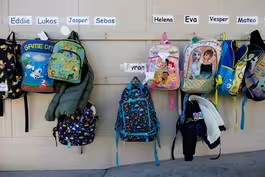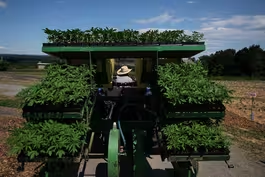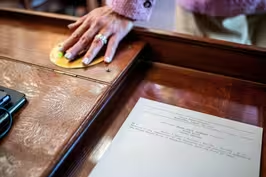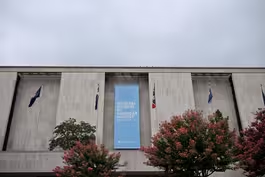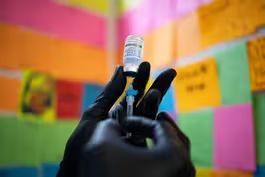
Florida’s climate tech sector faces uncertainty after cuts
Clip: 8/20/2025 | 8m 39sVideo has Closed Captions
Florida’s climate-focused tech sector faces uncertainty after federal cuts
South Florida is vulnerable to the impacts of climate change. Start-ups, local governments and researchers are working to make the area more resilient, but federal funding cuts may hinder those efforts. William Brangham traveled to the region and reports for our series, Tipping Point.
Problems playing video? | Closed Captioning Feedback
Problems playing video? | Closed Captioning Feedback
Major corporate funding for the PBS News Hour is provided by BDO, BNSF, Consumer Cellular, American Cruise Lines, and Raymond James. Funding for the PBS NewsHour Weekend is provided by...

Florida’s climate tech sector faces uncertainty after cuts
Clip: 8/20/2025 | 8m 39sVideo has Closed Captions
South Florida is vulnerable to the impacts of climate change. Start-ups, local governments and researchers are working to make the area more resilient, but federal funding cuts may hinder those efforts. William Brangham traveled to the region and reports for our series, Tipping Point.
Problems playing video? | Closed Captioning Feedback
How to Watch PBS News Hour
PBS News Hour is available to stream on pbs.org and the free PBS App, available on iPhone, Apple TV, Android TV, Android smartphones, Amazon Fire TV, Amazon Fire Tablet, Roku, Samsung Smart TV, and Vizio.
Providing Support for PBS.org
Learn Moreabout PBS online sponsorshipAMNA NAWAZ: The eye of Hurricane Erin, this season's first, passed about 450 miles east of Florida yesterday as it continued moving north in the Atlantic.
But the storm, which rapidly intensified last week, is a reminder of just how vulnerable South Florida is to the impacts of climate change.
For our series Tipping Point, William Brangham recently traveled to the region to explore how climate start-ups, local governments and researchers are working to make the area more resilient amid potential federal funding cuts that could hinder those efforts.
WILLIAM BRANGHAM: In an industrial warehouse in Miami, modern concrete printing is replicating something nature has done for millions of years.
ANYA FREEMAN, Founder CEO, Kind Designs: It's actually the world's fastest concrete 3-D printer.
WILLIAM BRANGHAM: Anya Freeman is the founder of Kind Designs, a climate and construction start-up.
It's kind of hypnotic to watch.
ANYA FREEMAN: It's very satisfying.
It's like frosting on a cake.
WILLIAM BRANGHAM: In roughly an hour, these thin layers of concrete will have added up to a 10-foot tall seawall, a barrier for where ocean meets land to protect property from the water.
But it's not just the printing that makes these unique.
The texture and elaborate design mimics the roots of Florida's ubiquitous mangrove trees, creating what Freeman calls a living seawall.
ANYA FREEMAN: So we have a library of designs customized for different marine habitats that's local.
So, in this case, this is a Miami Beach project.
It has the mangrove roots design.
And the point is to attract native species, these are very familiar shape for them, to create caves for them to hide from predators.
And also as a bonus, this also helps dissipate wave energy.
WILLIAM BRANGHAM: It's no surprise that this kind of work is being done in South Florida, because it's hard to think of another part of the country that's as threatened by climate change as this place is.
You have got increasing heat, increasingly powerful storms, and sea level rise.
TERRI-ANN BROWN, Miami Tech Works: For any start-up that wants to commercialize and grow their technology, they're going to find a space where they can do that here.
WILLIAM BRANGHAM: Terri-Ann Brown helps run what's called the Risk and Resilience Tech Hub, a region-wide effort that received nearly $20 million in federal funding last year to bring together academic institutions, local governments, and start-ups around new technologies focused on adapting to climate change.
The funding for the tech hub was just a sliver of the billions the Biden administration put towards fighting climate, money that is now facing new political headwinds.
DONALD TRUMP, President of the United States: As part of the One Big Beautiful Bill, we will also further slash the funding for the green new scam.
WILLIAM BRANGHAM: Since taking office, the Trump administration has sought to cancel tens of billions in climate grants and proposed ending millions in climate research.
The climate tech hub hasn't lost its money, and Brown argues this work is critical to keep building on Florida's progress, which began in earnest after Hurricane Andrew in 1992.
TERRI-ANN BROWN: We developed some really strong building codes that have really led what needs to happen in order to protect homes.
So, if anything, that gives us the opportunity to be the leading voice and the global producer when it comes to emerging technologies around this resilient space.
WILLIAM BRANGHAM: Florida International University in Miami is a key partner in the tech hub and a pioneer in building and designing products to survive in a warming world.
On its engineering campus, researchers can simulate a Category 5 hurricane to test building materials and designs, and it's planning to build a new facility to account for more powerful storms.
ATOROD AZIZINAMINI, Florida International University: This very process is that, first of all, I have to make sure that the aggregate is exposed.
WILLIAM BRANGHAM: Across campus, engineering professor Florida Atorod Azizinamini has developed an ultra-high-performance concrete that can be sprayed on to existing crumbling structures.
ATOROD AZIZINAMINI: The material is so dense, the material is seven, eight times stronger than regular concrete.
But the biggest aspect of this concrete is that it is so durable.
Nothing penetrates through it.
WILLIAM BRANGHAM: The concrete mix incorporates tiny steel fibers and is designed to repair infrastructure, like bridges, rather than having to replace them wholesale, saving money and the carbon footprint of rebuilding from scratch.
ATOROD AZIZINAMINI: Cement uses lots of energy, produces lots of CO2.
With this material, there's two advantages, first of all, use less of this one.
Number two, it's almost maintenance-free.
Rather than lasting 20 years, it's going to last you 100 years.
WILLIAM BRANGHAM: Azizinamini has already had a chance to try his spray-on technique in the real world, successfully repairing this bridge in Virginia last year.
He says he's received interest from several other states.
These emerging efforts, supported by the tech hub, are happening alongside a longstanding push by local governments to make South Florida more resilient to storms and floods and heat.
On Miami Beach, the nearly eight-square-mile barrier island across from Miami, the city has become a model, integrating climate adaptation into urban development.
AMY KNOWLES, Miami Beach Chief Resilience Officer: Very important to preserve all that we can.
Mangroves stabilize the shoreline.
WILLIAM BRANGHAM: The city's chief resilience officer, Amy Knowles, showed us a new city park on Biscayne Bay.
So if we were standing here before this project, how much lower would we be?
AMY KNOWLES: Yes, so we'd be about two feet lower.
WILLIAM BRANGHAM: Over the years, as flooding has gotten worse, the city has been forced to raise whole roads, build a pump system to move excess water out, and stiffen its building code.
AMY KNOWLES: Miami Beach and this area has so much to offer, but we're in Hurricane Alley and we can't necessarily pick up our island and move it.
We are the barrier to the mainland.
WILLIAM BRANGHAM: The city also started a program to subsidize improvements on private property.
MICHAEL PHILLIPS, Miami Beach Condo Owner: It's not going to be the full width.
WILLIAM BRANGHAM: In North Miami Beach, homeowner Michael Phillips is showing where a new seawall is being built behind a small condo building.
MICHAEL PHILLIPS: In the four years I have been here, I have observed the sea level come up at a couple inches.
It's a real thing and it's not going to stop.
WILLIAM BRANGHAM: Phillips' condo association decided to rebuild and raise its seawall when high tide waters kept overtopping it.
So how are you guys able to afford to do this?
MICHAEL PHILLIPS: It's a big hit for a small association like ours.
We're only 12 units.
These aren't million-dollar properties.
WILLIAM BRANGHAM: The building enrolled in the city-run grant program that covers the cost of an engineering consultation and a matching grant of up to $17,500.
That will cover less than a third of the total cost.
MICHAEL PHILLIPS: It's really just made it possible for us, considering this whole thing on our own is just going to be a stretch for a lot of our owners.
WILLIAM BRANGHAM: Given the enormity of the challenges that you all face, do you think there is enough funding to keep this city going?
AMY KNOWLES: For us, we're taking it one budget at a time.
We have brought in about $80 million in funding for resilience projects over the last couple of years.
We will continue to go after that grant funding, and we have been able to show results.
WILLIAM BRANGHAM: Knowles cites how infrastructure changes have kept the water at bay and prevented hundreds of tidal flood events.
In banking on the continued need for Floridians to adapt, Kind Designs is betting on itself and not tying its future to government funding.
ANYA FREEMAN: These are the completed living seawall panels.
WILLIAM BRANGHAM: Founder Anya Freeman says she's raised $11 million in recent years.
Her strategy, make a product that helps people combat climate-driven sea level rise, but makes a profit at the same time.
ANYA FREEMAN: You have to be a capitalist before you're an environmentalist if you want your idea to scale, because I see so many wonderful ideas and extremely well-meaning founders in the climate technology space, and the vast majority don't make it more than a year because it's just not affordable.
WILLIAM BRANGHAM: Absent government intervention or... ANYA FREEMAN: Oh, grants.
WILLIAM BRANGHAM: With or without federal support, the reality is that living in this low-lying storm-prone area means adapting for a warmer world isn't optional.
For the PBS "News Hour," I'm William Brangham in South Florida.
As Russia wages war, NATO plans Ukraine's future defense
Video has Closed Captions
Clip: 8/20/2025 | 3m 39s | As Russia continues to wage war, NATO meets to plan Ukraine's future defense (3m 39s)
As vouchers expand, public districts fighting to hold on
Video has Closed Captions
Clip: 8/20/2025 | 6m 47s | As voucher programs expand, many public school districts are fighting to keep students (6m 47s)
Expert analyzes difficulties of Ukraine security guarantees
Video has Closed Captions
Clip: 8/20/2025 | 5m 49s | Expert analyzes difficulties of providing Ukraine with security guarantees (5m 49s)
How marijuana reclassification could impact users, research
Video has Closed Captions
Clip: 8/20/2025 | 6m 29s | How the reclassification of marijuana could impact users, businesses and research (6m 29s)
News Wrap: Texas closer to approving new congressional maps
Video has Closed Captions
Clip: 8/20/2025 | 8m 34s | News Wrap: Texas lawmakers move closer to approving new congressional maps (8m 34s)
Scholar responds to Trump's efforts to reframe U.S. history
Video has Closed Captions
Clip: 8/20/2025 | 7m 10s | Scholar says Trump's efforts to reframe U.S. history is 'reminiscent of McCarthyism' (7m 10s)
Why the AAP is diverging from CDC vaccine guidelines
Video has Closed Captions
Clip: 8/20/2025 | 5m 55s | Why the American Academy of Pediatrics is diverging from CDC vaccine guidelines (5m 55s)
Providing Support for PBS.org
Learn Moreabout PBS online sponsorshipSupport for PBS provided by:
Major corporate funding for the PBS News Hour is provided by BDO, BNSF, Consumer Cellular, American Cruise Lines, and Raymond James. Funding for the PBS NewsHour Weekend is provided by...

